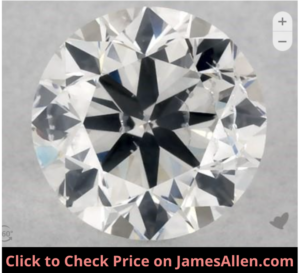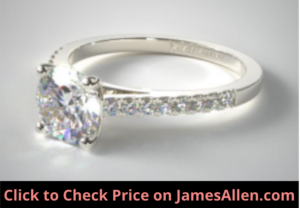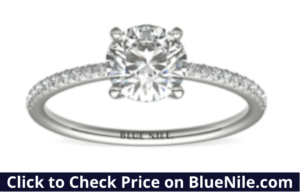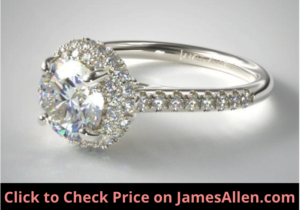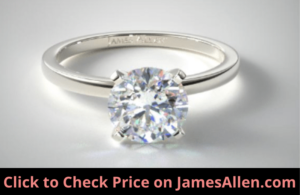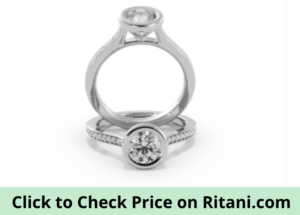- By Jacob Clarke
- jacob.clarke@teachjewelry.com
- Last Updated: October 2, 2023
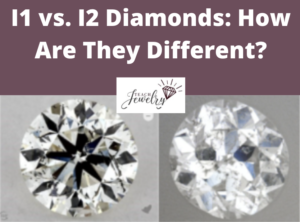
When diamonds are formed under the earth, they experience intense heat and pressure. This results in inclusions, or flaws, developing within their facets.
Diamonds are assigned clarity grades based on the extent of inclusions, ranging from flawless (FL) to included (I). Within the included category, there are three grades: I1, I2, and I3.
The main difference between I1 and I2 diamonds is that I1 diamonds often have fewer inclusions that are less impactful to its brilliance, durability, and visual appeal. I2 diamonds have significant inclusions that are easily noticeable, causing the diamond to appear dull with obvious imperfections scattered across the stone.
Let’s compare I1 versus I2 diamonds, including an overview of each clarity grade, how they’re different, similarities, and why we recommend higher clarity grades.
What are I1 Diamonds?
I1 is the ninth position on the GIA clarity scale. It sits above I2 and below SI2.
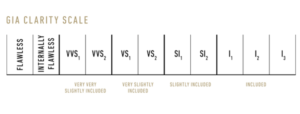
I1 diamonds are designated “included,” but a more accurate description would be “heavily included” because there are only two clarity grades below them.
When gemologists are examining them, the inclusions are easily noticeable with and without 10x magnification.
It’s not referring to an exact number or type of inclusion. Instead, it indicates the flaws are widespread and affect every aspect of the diamond’s performance.
For example, take a close look at this round-cut I1 diamond from James Allen.
On the right side of the image, you’ll notice several occurrences of feather inclusions. They’re long and extend across multiple facets.
On the other hand, the inclusions are generally white or transparent, which means they’re less visible without magnification.
As a contrast, here’s another I1 diamond. The imperfections are small, dark, and numerous.
But the gemologist determined the overall effect of the inclusions is similar between both diamonds.
What are I2 Diamonds?
I2 is the second lowest position on the clarity scale. It’s one step above I3 and one below I1.
I2 diamonds exhibit heavy inclusions. If the stone is more than 0.5 carats, they’re immediately noticeable when viewed in a normal setting.
For some clarity grades, gemologists have to scan the diamond back and forth to discover the inclusions. This isn’t the case with I2 diamonds.
It could have any combination of inclusions such as:
- Needles
- Feathers
- Cavities
- Twinning wisps
One characteristic that’s often true of I2 diamonds is blemishes are clustered together.
While a single inclusion might hide from the naked eye, they become more noticeable when several are positioned in the same area.
The inclusions are also often large.
For example, here’s the GIA report for this I2 diamond.
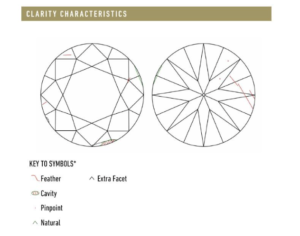
Notice the long feather extending on the pavilion view. This diamond wasn’t graded I2 because of the small pinpoints. It was a combination of the large cavity near the crown and the feather.
This demonstrates how it’s often a number of factors that contribute to a diamond’s clarity grade.
What are the Differences Between I1 and I2 Diamonds?
If you’re comparing I1 versus I2 diamonds, you should know how the inclusions affect each aspect of the diamond’s performance.
Clarity grades go beyond explaining the distinctions in visible appearance.
Here are the details on four differences between I1 and I2 diamonds.
1. I1 Diamonds Often Have Fewer Inclusions
Although diamond clarity isn’t an indicator of an exact number of inclusions, I1 diamonds often have fewer inclusions than ones that earn an I2 grade.
That’s because if all else is equal, a higher number of inclusions is more detrimental to its quality.
As examples, let’s compare this I1 diamond with this I2 diamond. Both have reports from the GIA that identify the size, type, and number of inclusions.
The I1 diamond has the following inclusions:
- Clouds
- Pinpoints
- Crystals
- Feathers
- Needles
- Naturals and indented naturals
Here’s the GIA report with the details.
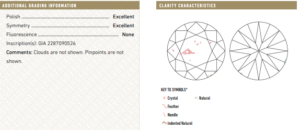
The I2 diamond has all of these flaws, including cavities.
Check out its GIA report below.
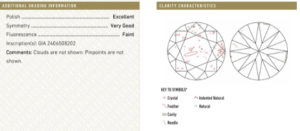
Not only does it have additional types of inclusions, there are also more instances of them.
The entire table is covered with needles, crystals, and more.
There are plenty of exceptions to this rule. You may find an I2 diamond with only a few issues, but they’re large and impactful.
An I1 diamond could have dozens of inclusions, but they’re small and transparent, which keeps it from earning an I2 or I3 clarity grade.
2. I2 Diamonds Exhibit Low Brilliance
Inclusions don’t only result in noticeable flaws. It also impacts brilliance.
I2 diamonds exhibit lower brilliance compared to I1 clarity because inclusions distort the path through which light enters and exits facets.
In a flawless diamond with a quality cut, light can enter the diamond, bounce around inside, and return to the viewer.
When light encounters an inclusion, it doesn’t follow this ideal path.
This can result in a dull diamond.
For example, here’s a ring with an I2 diamond.
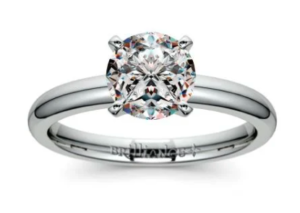
Even though it earned an “excellent” cut grade, this ring won’t show much sparkle when it’s twirled.
There’s a huge feather near the crown, with feathers and needles on the table. Light can’t travel a clean path through the gem.
But you shouldn’t have high expectations for I1 diamonds either. In fact, you likely won’t notice a difference between their brilliance when viewed in a normal setting.
Let’s take this I1 diamond ring as an example.
There are black spots and feathers all over the table and pavilion. Despite a “very good” cut grade, it’ll appear dull.
3. I1 Diamonds Sell for a Higher Price
Diamonds that earn higher clarity grades are more expensive because buyers are willing to pay a premium for fewer inclusions.
Flawless diamonds are significantly more expensive than even ones graded VVS, VS, or SI.
The same idea is true when you compare diamonds within the same clarity category, like I1 and I2.
As an example, this one-carat I2 diamond has a very good cut and J color grade.
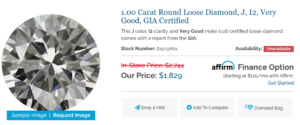
It costs $1,829.
We compiled prices for 33 diamonds from James Allen that had the same qualities, except they earned an I1 color grade.
The average cost was $3,027, with a range of $2,180-$4,070.
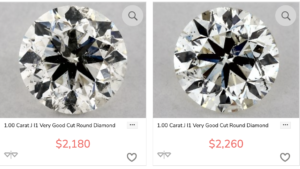
That’s a 66 percent premium for the I1 diamonds over I2.
Even the least expensive I1 diamond from James Allen cost more than the I2 diamond.
As a general rule, you can expect one step on the clarity grade to raise or lower the price by 10 to 20 percent. If you move from one category to another, like VS to VVS, it’s often on the high end of that range.
We recommend searching for an eye-clean diamond because you’ll save on price compared to ones that earned higher grades but look identical.
4. I2 Diamonds are Rarely Used in Jewelry
It’s rare to find I2 diamonds used in pieces of jewelry because of their heavy inclusions. In fact, you’ll almost never see them as the main gem in a diamond ring.
If they’re placed on a ring, it’s often as a side stone or pavé.
In these cases, the diamonds are so small that the inclusions aren’t visible. The goal isn’t for them to sparkle or steal attention but to instead complement the main diamond.
For example, a petite micropavé setting like this one could include I2 diamonds.
The total carat weight of the setting is 0.09. The 22 diamonds are so tiny that you wouldn’t see inclusions without magnification.
So using I2 diamonds would lower the cost.
I1 diamonds aren’t popular choices for diamond rings, but you’ll find more of them on the market than ones with I2 clarity.
James Allen has more than 6,000 round-cut, I1 diamonds available, but other popular online diamond stores don’t sell ones below SI2.
Here’s a diamond ring with an I1 diamond at the center surrounded by a halo.
Because the diamond is only 0.80 carats, and the inclusions are white and transparent, it looks cleaner than most in the included category.
But similar to I2 diamonds, ones graded I1 more frequently serve as side stones and as pavé on the shank.
It’s an affordable way to add more gems to the piece while keeping the attention on the center diamond.
Are There Any Similarities?
There are also several similarities between I1 and I2 diamonds.
The first is that they’re rarely eye-clean. Although I1 diamonds earn the higher grade, they both have too many inclusions to hide, even to the naked eye.
You may find ones below 0.5 carats that fit this category, but if you’re searching for an eye-clean diamond, we recommend starting your search at SI2 and SI1.
Relatedly, this makes them a poor choice for engagement ring diamonds. It’s worth the extra cost associated with clarity to find a center diamond without black spots or crystals distracting from its brilliance.
Obvious flaws like these diminish their appeal.
I1 and I2 diamonds also lack trade-in value. It’s commonly thought that natural diamonds increase in value over time, but this is the exception.
Most lose a significant amount of their value when they leave the store.
This is especially true of ones with low clarity grades because there are so many that look identical.
The vast majority of diamonds rank on the low end of the clarity scale, which is why cleaner ones sell for higher prices.
Lastly, I2 and I1 diamonds have durability issues. Inclusions represent weak areas in a diamond’s structure, so they’re more vulnerable to drops and hits.
You should protect these areas with a strong setting.
This doesn’t necessitate a style like bezel settings, but other types leave them more exposed.
Fancy shapes with sharp points like princess, pear, and marquise cuts are even more susceptible if they’re heavily included.
Should You Buy an I1 or I2 Diamond?
We recommend choosing a diamond with a higher clarity grade than I1 or I2.
It’s difficult to find one close to one carat that doesn’t show inclusions. When it comes to the center diamond in your ring, you want to avoid these issues.
Instead, start with SI2 and SI1 diamonds and work your way to VS2 and VS1. If you choose a diamond greater than two carats, you may have to continue up the clarity scale.
But if there are pavé diamonds around the main one or on the shank, it may appear clean with I1 or I2 diamonds. View the piece in person or through high-resolution photos before you commit.
By understanding how inclusions affect I1 and I2 diamonds, and why you should choose one with a higher clarity, you’ll discover the right diamond for your ring.

Jacob Clarke
Jacob Clarke is the founder of TeachJewelry.com.
He earned an Applied Jewelry Professional Diploma from the Gemological Institute of America (GIA) and now brings you essential information about diamonds, settings, and more.
Jacob has consulted with leading jewelry brands, and his work has been cited in Clean Origin, Diamond Nexus and industry publications.
He's also a member of the International Gem Society.
He enjoys discussing jewelry with readers, so contact him with any questions at jacob.clarke@teachjewelry.com.

